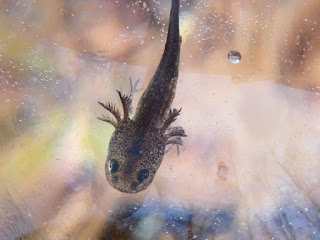By Brian Williams and Dr. Ariana Kuhn
"It’s February, it’s dark, it’s raining – lets go!”
While most humans may prefer a warm fire, a glass of wine, and a Valentine’s dinner, herpetologists are pulling on wading boots and rain gear, strapping on headlamps. and heading to the ditches and vernal pools with nets and cameras. So if you see some crazy folks wandering around in the woods on a rainy February night, don’t worry. It's just your local “herpers” out trying to catch the annual nuptial dance of the spotted salamander (Ambystoma maculatum).
The “Liebespiel” only takes place over a few nights in February and you have to be at the right place at the right time to see these magnificent spotted miracles performing their dance. Even if you don’t see the mating ritual, you might still be lucky enough to catch sight of a few of these impressive salamanders with two rows of bright yellow spots along their backs. Every spring, they migrate from the forest to wetland ditches and vernal pools to breed. Males usually arrive first, dropping spermatophores on small underwater vegetation where females will take these packets into their cloacas to fertilize their eggs and redeposit them on the vegetation in a sticky gelatinous mass. Each mass contains 100 to 200 eggs. The egg masses are quite easy to see, clinging to the underwater twigs with little black dots inside each egg sack (often seen together, wood frog egg masses and other salamander masses can look similar). The adults leave the pool after a few days, leaving their eggs behind. The larval salamanders hatch within a month or two and become salamanders in two to four months. The vernal pools are ideal sanctuaries for these eggs and larvae to grow, as they contain no fish predators. The best pools have lots of scuds and other macro invertebrates that the larvae feed on before they metamorphose, loose their gills, and begin the next part of their adult lives on land.
The first week of February saw major rains and it was evident by the road kills that the amphibians were taking advantage of the water levels in the ephemeral pools. Although we could not get out on this first rainfall event, several nights later we did manage to check out several locations and find not only spotted salamanders, but a few of the other amphibian harbingers of spring. The spring peeper (Pseudacris crucifer) is the call that most will recognize, sometimes you can even hear it through the rolled-up windows of your car as you pass by low lying areas with standing water. But this time of year you can also hear the raspy plunk of the wood frog (Lithobates sylvaticus), the resonating croak of green frog (Lithobates clamitans), and the cricket-like trill of the upland chorus frog (Pseudacris feriarum). The eatsern newt (Notophthalmus viridescens) are also common in some of these same locations this time of year, as they are doing their own underwater courtship dance.
Such a brief moment in time between egg deposition and when these “wetland wonders” head back underground for another year. They can live up to 20 years and return to the same pools each year, so it is important that we protect these sensitive areas.
Participating in early spring identification and monitoring of aquatic systems that support vernal breeding amphibians is a valuable resource to conservation, research, and ecosystem health. This data not only helps reinforce accurate geographic ranges and environmental preference of species, but also key information about the timing of biological events, such as breeding and development. Over time, threats like climate change could cause major shifts in these events, which could have serious implications for sensitive amphibians. Additionally, mapping out areas that are essential to many vernal breeders can benefit conservation and restoration projects that provide critical habitat to some of our less frequently seen, but incredible native species, like the spotted salamander.
 |
| Spotted Salamander (Ambystoma maculatum) | Image by Brian Williams |
 |
 |
| Vernal Pool | Image by Brian Williams |




Very interesting that the salamanders are out and about on chilly, rainy nights. Thanks for the article.
ReplyDelete